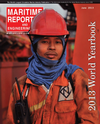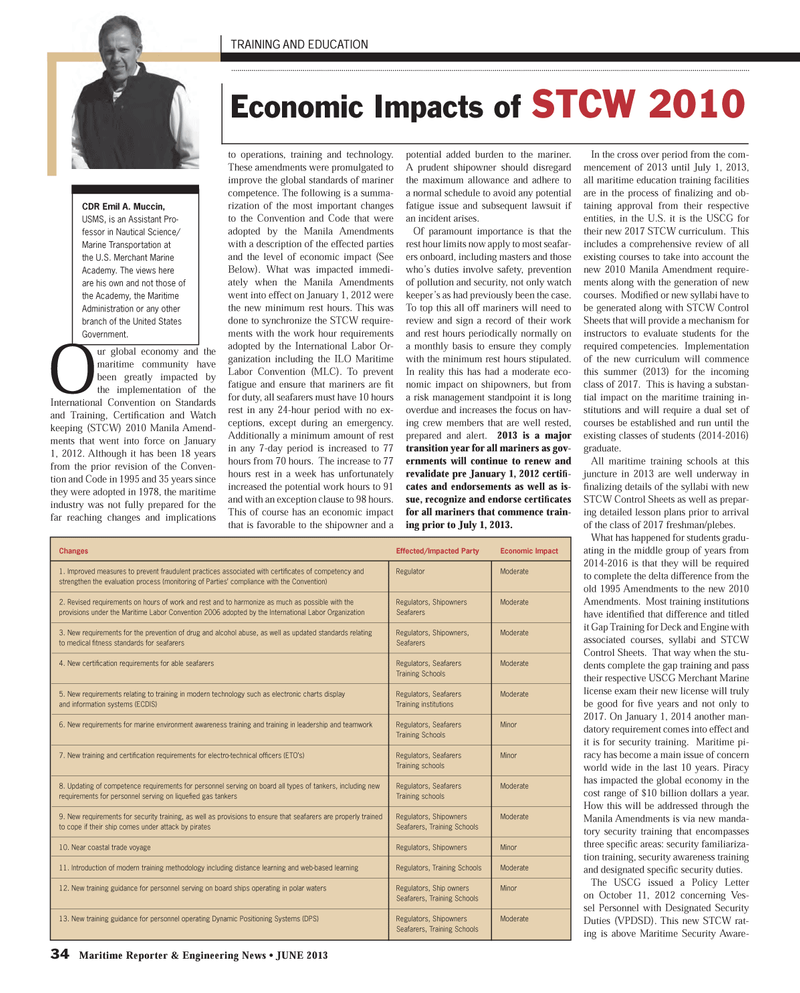
Page 34: of Maritime Reporter Magazine (June 2013)
Annual World Yearbook
Read this page in Pdf, Flash or Html5 edition of June 2013 Maritime Reporter Magazine
34 Maritime Reporter & Engineering News ? JUNE 2013 TRAINING AND EDUCATION Economic Impacts of STCW 2010Our global economy and the maritime community have been greatly impacted by the implementation of the International Convention on Standards and Training, Certi Þ cation and Watch keeping (STCW) 2010 Manila Amend- ments that went into force on January 1, 2012. Although it has been 18 years from the prior revision of the Conven-tion and Code in 1995 and 35 years since they were adopted in 1978, the maritime industry was not fully prepared for the far reaching changes and implications to operations, training and technology. These amendments were promulgated to improve the global standards of mariner competence. The following is a summa- rization of the most important changes to the Convention and Code that were adopted by the Manila Amendments with a description of the effected parties and the level of economic impact (See Below). What was impacted immedi- ately when the Manila Amendments went into effect on January 1, 2012 were the new minimum rest hours. This was done to synchronize the STCW require- ments with the work hour requirements adopted by the International Labor Or- ganization including the ILO Maritime Labor Convention (MLC). To prevent fatigue and ensure that mariners are Þ t for duty, all seafarers must have 10 hours rest in any 24-hour period with no ex-ceptions, except during an emergency. Additionally a minimum amount of rest in any 7-day period is increased to 77 hours from 70 hours. The increase to 77 hours rest in a week has unfortunately increased the potential work hours to 91 and with an exception clause to 98 hours. This of course has an economic impact that is favorable to the shipowner and a potential added burden to the mariner. A prudent shipowner should disregard the maximum allowance and adhere to a normal schedule to avoid any potential fatigue issue and subsequent lawsuit if an incident arises. Of paramount importance is that the rest hour limits now apply to most seafar- ers onboard, including masters and those who?s duties involve safety, prevention of pollution and security, not only watch keeper?s as had previously been the case. To top this all off mariners will need to review and sign a record of their work and rest hours periodically normally on a monthly basis to ensure they comply with the minimum rest hours stipulated. In reality this has had a moderate eco-nomic impact on shipowners, but from a risk management standpoint it is long overdue and increases the focus on hav-ing crew members that are well rested, prepared and alert. 2013 is a major transition year for all mariners as gov- ernments will continue to renew and revalidate pre January 1, 2012 certi Þ -cates and endorsements as well as is-sue, recognize and endorse certi Þ cates for all mariners that commence train- ing prior to July 1, 2013. In the cross over period from the com-mencement of 2013 until July 1, 2013, all maritime education training facilities are in the process of Þ nalizing and ob- taining approval from their respective entities, in the U.S. it is the USCG for their new 2017 STCW curriculum. This includes a comprehensive review of all existing courses to take into account the new 2010 Manila Amendment require- ments along with the generation of new courses. ModiÞ ed or new syllabi have to be generated along with STCW Control Sheets that will provide a mechanism for instructors to evaluate students for the required competencies. Implementation of the new curriculum will commence this summer (2013) for the incoming class of 2017. This is having a substan- tial impact on the maritime training in-stitutions and will require a dual set of courses be established and run until the existing classes of students (2014-2016) graduate. All maritime training schools at this juncture in 2013 are well underway in Þ nalizing details of the syllabi with new STCW Control Sheets as well as prepar- ing detailed lesson plans prior to arrival of the class of 2017 freshman/plebes.What has happened for students gradu-ating in the middle group of years from 2014-2016 is that they will be required to complete the delta difference from the old 1995 Amendments to the new 2010 Amendments. Most training institutions have identiÞ ed that difference and titled it Gap Training for Deck and Engine with associated courses, syllabi and STCW Control Sheets. That way when the stu- dents complete the gap training and pass their respective USCG Merchant Marine license exam their new license will truly be good for Þ ve years and not only to 2017. On January 1, 2014 another man-datory requirement comes into effect and it is for security training. Maritime pi-racy has become a main issue of concern world wide in the last 10 years. Piracy has impacted the global economy in the cost range of $10 billion dollars a year. How this will be addressed through the Manila Amendments is via new manda- tory security training that encompasses three speciÞ c areas: security familiariza- tion training, security awareness training and designated speciÞ c security duties. The USCG issued a Policy Letter on October 11, 2012 concerning Ves- sel Personnel with Designated Security Duties (VPDSD). This new STCW rat- ing is above Maritime Security Aware- CDR Emil A. Muccin, USMS, is an Assistant Pro- fessor in Nautical Science/Marine Transportation at the U.S. Merchant Marine Academy. The views here are his own and not those of the Academy, the Maritime Administration or any other branch of the United States Government.Changes Effected/Impacted Party Economic Impact 1. Improved measures to prevent fraudulent practices associated with certiÞ cates of competency and Regulator Moderatestrengthen the evaluation process (monitoring of PartiesÕ compliance with the Convention) 2. Revised requirements on hours of work and rest and to harmonize as much as possible with the Regulators, Shipowners Moderate provisions under the Maritime Labor Convention 2006 adopted by the International Labor Organization Seafarers 3. New requirements for the prevention of drug and alcohol abuse, as well as updated standards relating Regulators, Shipowners , Moderateto medical Þ tness standards for seafarers Seafarers 4. New certiÞ cation requirements for able seafarers Regulators, Seafarers Moderate Training Schools 5. New requirements relating to training in modern technology such as electronic charts display Regulators, Seafarers Moderateand information systems (ECDIS) Training institutions 6. New requirements for marine environment awareness training and training in leadership and teamwork Regulators, Seafarers Minor Training Schools 7. New training and certiÞ cation requirements for electro-technical ofÞ cers (ETOÕs) Regulators, Seafarers Minor Training schools 8. Updating of competence requirements for personnel serving on board all types of tankers, including new Regulators, Seafarer s Moderaterequirements for personnel serving on liqueÞ ed gas tankers Training schools 9. New requirements for security training, as well as provisions to ensure that seafarers are properly trained Regulators, Shi powners Moderateto cope if their ship comes under attack by pirates Seafarers, Training Schools 10. Near coastal trade voyage Regulators, Shipowners Minor 11. Introduction of modern training methodology including distance learning and web-based learning Regulators, Training Schools Moderate12. New training guidance for personnel serving on board ships operating in polar waters Regulators, Ship owners Minor Seafarers, Training Schools 13. New training guidance for personnel operating Dynamic Positioning Systems (DPS) Regulators, Shipowners Moderate Seafarers, Training Schools MR #6 (34-41).indd 34MR #6 (34-41).indd 345/30/2013 1:03:14 PM5/30/2013 1:03:14 PM

 33
33

 35
35
